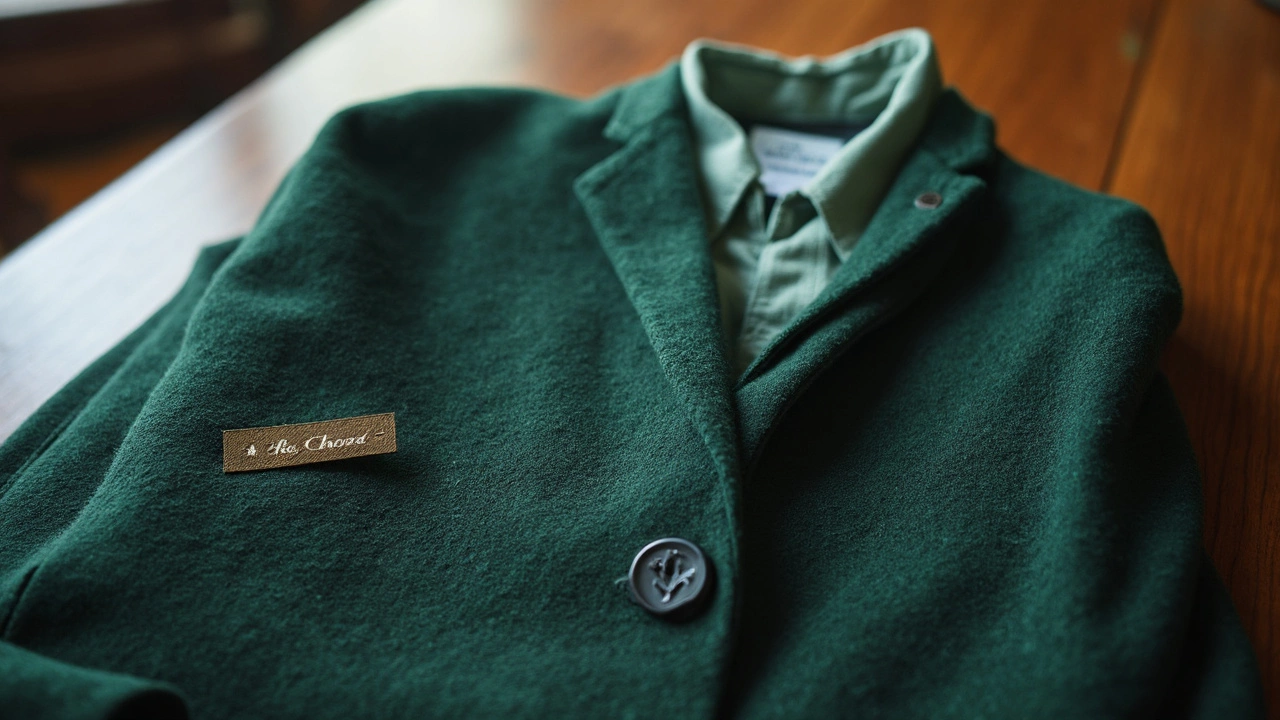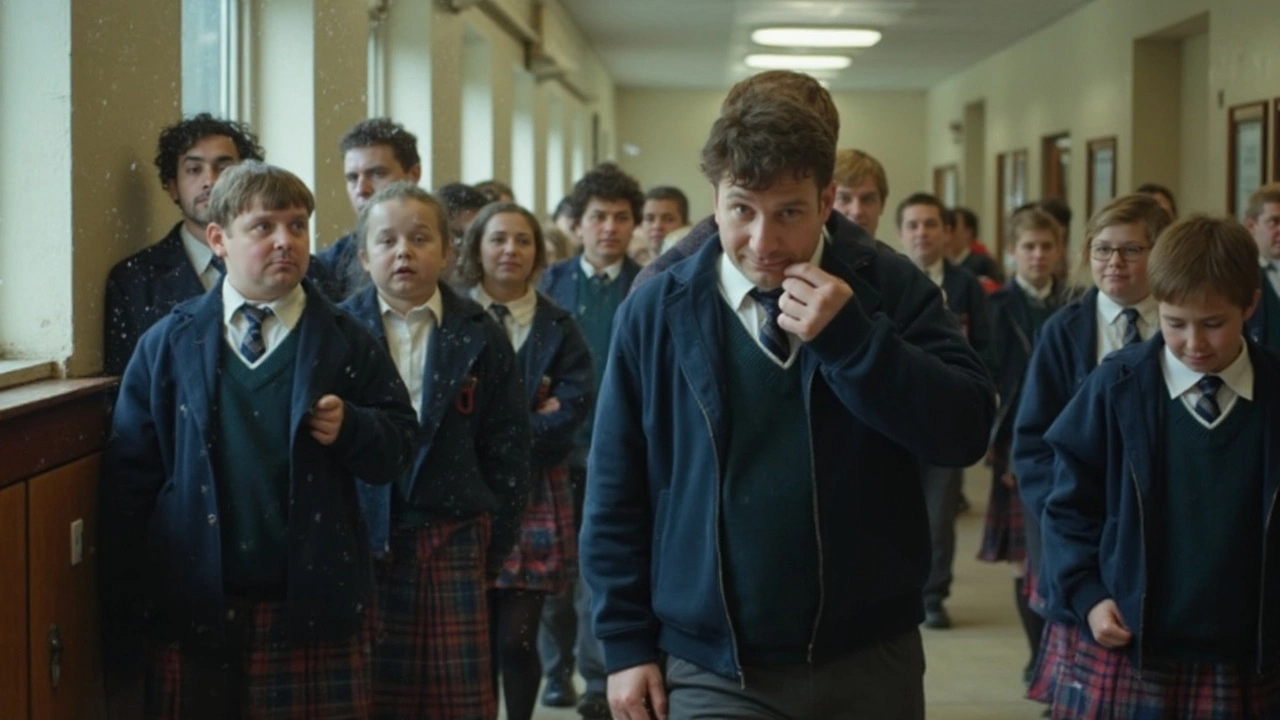If you've ever spent a September morning in Ireland, you know that the wrong school uniform can turn a misty walk to school into pure misery. Irish students aren’t just dealing with plain shirts and pants—think pleated wool skirts in Donegal, scratchy jumpers in Galway, and those all-too-familiar polyester blazers that seem to trap every last bit of heat (or cold) everywhere from Cork to Belfast. With Ireland’s famous four-seasons-in-a-day weather, comfort isn’t some soft debate, it’s a daily fight.
A survey from 2023 by Barnardos Ireland showed that nearly half of Irish students found parts of their uniform uncomfortable. The most common complaints? Stiff collars, itchy fabrics, and tights that slip by lunchtime. Kids who play GAA after school often tell you it’s a relief to finally ditch the tie and those heavy shoes. Even parents end up having to buy extra jumpers just to keep their kids warm while waiting for the bus in November.
- What Irish Students Really Wear
- The Comfort Struggles (and Why They Happen)
- Uniform Hacks for Irish Weather
- How to Handle Complaints and Push for Change
What Irish Students Really Wear
Take a look around any Irish town at school drop-off and you’ll see similar patterns: navy and bottle-green jumpers, grey trousers or skirts, and the ever-present school crest stitched onto blazers. These school uniforms may look the same from a distance, but each has its own awkward details. Most secondary schools stick with the classic: v-neck jumper, collared shirt, tie (yes, even for the younger lads and girls), and either trousers or pleated skirts. Some schools allow cardigans, but blazers are still king for most.
Primary schools in Ireland usually go for something more relaxed, like polo shirts and sweatshirts with the school name embroidered in. This doesn’t mean they’re always comfy, though. The material is often a heavy polyester mix, which holds up to rain (sort of), but can get pretty hot when the sun shows up out of nowhere.
If you’re part of a Gaelscoil, uniforms might sneak in a bit more colour. Red jumpers at Scoil na nÓg in Dublin, or emerald green in parts of Kerry, mix things up. But the basics are still there: uniformity, tradition, and practicality for Irish weather. Private schools sometimes bring in blazers and even loafers — not much fun on a rainy January morning.
Check out this breakdown from the Department of Education's 2023 report showing how common certain items are in Irish schools:
| Uniform item | Primary schools (%) | Secondary schools (%) |
|---|---|---|
| Jumper/Sweatshirt | 97 | 91 |
| Collared shirt | 82 | 100 |
| Blazer | 9 | 77 |
| Tie | 28 | 93 |
| Skirt | 36 | 61 |
| Trousers | 92 | 88 |
Brands like Schoolwear House, O'Neill’s, and even Dunnes Stores sell the bulk of these school uniforms. Parents here know the drill—buy bigger so there’s room to grow, and keep a spare set for when the inevitable mud shows up after break. Some schools let kids wear PE kits one or two days a week, which honestly is a relief for almost everyone involved.
As one principal in Galway put it,
"Uniforms give a sense of belonging, but finding something comfortable and lasting in Irish weather is a challenge. Parents and kids both want less fuss, warmer fabrics and easier options."
If your child has allergies or sensory needs, you’re not alone—most schools in Ireland will work with you on tweaks like switching out the standard tie or skipping the blazer. Chat to the principal or uniform supplier if comfort is a problem. There’s almost always some wiggle room, even if it takes a bit of pushing.
The Comfort Struggles (and Why They Happen)
When it comes to school uniforms in Ireland, most people assume the biggest complaints will be about the style or colour. But if you talk to students or parents for five minutes, you’ll hear that comfort is the real issue. Uniforms here are often made from blends that focus more on durability than how they actually feel on your skin. Wool-blend jumpers may stand up to the Irish rain, but anyone with eczema or sensitive skin knows they can be torture by midday.
Irish school blazers tend to come from a handful of local suppliers—people will mention names like O’Neills or Schoolwear House. While these brands are reliable, they often use thicker polyester that makes you sweat on a crowded Dublin Bus, but somehow still doesn’t keep you warm on a January morning in Limerick. And even though everyone jokes about the ‘one size fits no one’ trousers, it really does affect day-long comfort.
| Uniform Item | Common Complaint |
|---|---|
| Blazer | Too hot in summer, itchy collars |
| Skirt | Rides up, too stiff, tough to adjust |
| Tights | Fall down, snag easily, cold in wind |
| Shirt | Starch irritates neck, hard to move in |
Girls talk a lot about tights—especially in schools where trousers aren’t allowed. Irish winters and cheap nylon don’t mix. Tights sag, tear, or just never keep your legs warm enough when you’re crossing a windswept schoolyard in Portlaoise. Meanwhile, stiff collars and buttoned-up shirts feel extra rough by the end of a triple class.
It’s not just picky students, either. School nurses report more skin irritation and even minor injuries during sports days, all because the uniform didn’t fit right or trapped too much moisture. Parents get frustrated with the cost. If your child is uncomfortable, you’re buying extra PE kits, undershirts, or even paying a seamstress to adjust hem lengths.
Most Irish secondary schools resist switching to more flexible options because they want uniforms to look smart, and they last longer if they’re made from strong stuff. But this comes at a price—real-world discomfort that affects students’ ability to focus and take part in things like lunchtime football or even just feeling comfortable in class.

Uniform Hacks for Irish Weather
There’s no denying it—trying to keep comfortable in your school uniforms during Ireland’s ever-changing weather is almost like a sport in itself. Everyone’s wrestled with being cold on the walk to school, boiling hot by mid-morning, and drenched before English class. So, how do the pros handle it?
First things first: layering is your best friend. Most Irish schools technically require students to wear the branded jumper or cardigan on top, but nothing’s stopping you from sneaking a thin thermal vest underneath. Marks & Spencer and Dunnes Stores both stock plain white thermals that fit right under those itchy shirts—no one’s the wiser, and you’ll stay warmer when the rain picks up.
On days when that classic Dublin drizzle turns heavy, an actual waterproof jacket (rather than the school’s blazer) makes all the difference. Some schools are strict, so try to find a navy or black jacket that blends in. If your school’s a bit looser, SuperValu and Regatta have solid back-to-school offers every August with waterproofs that don’t break the bank.
Irish students are experts at picking their battles. For chilly bus stops or lunchtime outside, lots of girls double up on tights—opaque over the standard pair, or swap for fleece-lined ones from Penneys. Boys often go with thermal socks from Lidl or Dunnes, especially during January cold snaps. Believe me, it works.
- Wear a thin vest or base layer under your shirt.
- Swap school jumper for a thermal-lined cardigan at home if allowed.
- Use waterproof jackets on your way to school—even if you stash it in your bag once indoors.
- Double up on tights, or try thicker, heat-retaining socks.
- Let shoes dry overnight; newspaper stuffed inside speeds it up after a soaking.
Some parents swear by buying two sets of school uniforms: one in slightly larger sizes to fit all those hidden layers. Yes, it’s an extra investment, but it means kids don’t end up shivering all day, especially in counties like Mayo or Kerry where the wind can get brutal.
Here’s a quick look at what parents reported worked best for their kids last winter, according to a small parent survey from the Irish Primary Principals' Network:
| Weather Condition | Popular Hack |
|---|---|
| Cold mornings | Thermal vests and two pairs of socks |
| Heavy rain | Packed waterproof, swapped shoes on arrival |
| Windy afternoons | Wool beanies (where rules allow) |
| Sudden sun | Vest and jumper easy to peel off |
At the end of the day, sometimes you have to bend the rules to survive the Irish weather in your school uniforms. Teachers get it too—most are happy as long as you’re not making a fashion statement out of a raincoat or turning your jumper inside out (though I’ve seen that happen after a spill in the canteen!).
How to Handle Complaints and Push for Change
If your child comes home moaning about their school uniform, you’re not alone. Nearly every Irish parent or student has faced the same hassle—uncomfortable collars, shorts banned in summer, or blazers that leave arms red and itchy. The good news: you don’t have to just put up with it. Lots of schools in Ireland have recently updated their uniform policies because parents and students spoke up together.
First thing—know your school’s process. Most schools have a Board of Management and a Parents’ Association. That’s where uniform issues get a real hearing. Gather specific examples—photos of rashes caused by polyester, or emails about how cheap trousers from certain shops rip too quickly. In 2022, St. Patrick’s National School in Navan introduced new, softer jumpers after dozens of parents sent photos and receipts showing repeated replacement costs. It made local news because the whole Parents’ Association backed it.
- Start by talking to your child’s teacher or year head. They might know others feel the same and can point you to the right person to talk to next.
- Collect feedback from other families. WhatsApp groups and school Facebook pages are the easiest ways to do this, especially for organizing petitions or surveys.
- Bring your concerns (and examples) to the Parents’ Association meeting. The more real stories and data you have, the tougher you are to ignore.
- If nothing changes, talk to your local TD or city council. Uniform comfort became a hot topic in the Dáil in 2023, so you’re not overreacting.
A lot of Irish schools, like St. Vincent’s in Glasnevin and several Educate Together schools, have introduced more flexible and comfortable options when complaints were persistent and well-documented. Going in as a group, and having numbers to back up what you’re saying, really does make a difference.
| Item | % Schools Adjusting |
|---|---|
| Fabric/type (softer or breathable) | 62% |
| Allowing trousers for girls | 58% |
| Bringing in polo shirts/t-shirts | 47% |
| Footwear (e.g. runners allowed) | 37% |
If you worry about cost, don’t forget—since 2021, many Irish schools joined the Department of Education’s Affordable Uniform Scheme, making it easier to afford changes. When people band together, clunky uniforms really do get swapped out in Irish schools. Don’t be afraid to get involved and speak up. Every itchy jumper you complain about now might mean a comfier day for kids next year.
